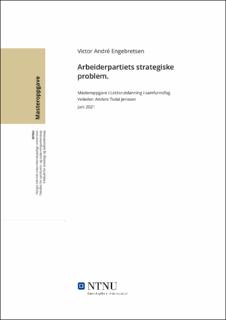| dc.contributor.advisor | Jenssen, Anders Todal. | |
| dc.contributor.author | Engebretsen, Victor André. | |
| dc.date.accessioned | 2021-09-28T17:35:09Z | |
| dc.date.available | 2021-09-28T17:35:09Z | |
| dc.date.issued | 2021 | |
| dc.identifier | no.ntnu:inspera:80180343:9901694 | |
| dc.identifier.uri | https://hdl.handle.net/11250/2784597 | |
| dc.description.abstract | I denne studien analyseres Arbeiderpartiets oppslutning i valgene 2009 og 2017 i lys av nærhetsteorien (medianvelgerteoremet) og retningsteorien, og hvordan de kan belyse Arbeiderpartiets problemer med oppslutningen. De to ulike teoriene hevder at to ulike posisjoner i det politiske rommet er gode for å vinne velgere. Nærhetsteorien hevder partiet som legger seg nærmest medianvelgeren i politiske spørsmål tjener på dette. Retningsteorien hevder partier tjener på å vise retning og intensitet i politiske saker, og at velgere ikke nødvendigvis stemmer på partier de er nærmest i det politiske rommet. Ved å sammenligne partiposisjon og velgerposisjon på ulike politiske dimensjoner, forsøker studien å finne ut hvordan Arbeiderpartiet har blitt styrt, og hvilke konsekvenser dette kan ha ført til. Studien tar særlig for seg de ideologiske dimensjonene offentlig-privat, innvandring, vekst-vern og sentrum-periferi. Funnene i oppgaven indikerer at Arbeiderpartiet har beveget seg mot sentrum på de tre siste dimensjonene. Samtidig har disse tre dimensjonene blitt stadig viktigere for velgere i den aktuelle tidsperioden. Dette har videre ført til at partiet taper velgere til partier som viser større retning og intensitet på dimensjonene. Empirien i studien taler derfor for at Arbeiderpartiet har blitt styrt av nærhetsteorien i perioden, og at dette har ført til at partiet har tapt oppslutning. Studien drøfter også ulike grunner til at partiet har blitt styrt på denne måten i perioden. | |
| dc.description.abstract | This study analyses the Norwegian Labour Party and its support in the elections of 2009 and 2017 in light of the proximity theory and the directional theory. The two theories propose two different strategies for maximising voter support. The proximity theory argues that the voter will vote for the party that is closest to him/her in political questions. Therefore, it is advised for a party to take up political positions which is closest to the median voter. The directional theory, on the other hand, proposes a different strategy. According to the directional theory, voters vote for a party that shows more intensity and direction in a political question. This study uses the two theories in an attempt to shed a light on why the Norwegian Labour Party in recent years have struggled to maintain and gain voters. The study focuses on four political dimensions: one economic left-right-dimension, one regarding immigration, one regarding climate, and one regarding urban-rural. Comparing party position and voter positions, the study finds that the party has moved towards the centre of the last three of said political dimensions. These dimensions have also become more important in the Norwegian political landscape in the time period between 2009-2017. The study argues that this centre-shifting position from the Norwegian Labour Party has led to the party losing support to other parties which shows more direction on the same dimensions. The study therefore conclude that The Norwegian Labour Party has been using the proximity theory in their political strategy in the period of 2009-2017. Furthermore, the study also discusses different reasons as to why this has happened. | |
| dc.language | nob | |
| dc.publisher | NTNU | |
| dc.title | Arbeiderpartiets strategiske problem. | |
| dc.type | Master thesis | |
